Edit: Ignore the old information, and see Solved solution below:
The following code works an example text file: input.txt
velocity 4
0 0
0.0800284750334461 0.0702333599787275
0.153911082737118 0.128537103048848
0.222539323234924 0.176328826156044
0.286621942300277 0.21464146333504
0.346732028739683 0.244229944930359
0.403339781262399 0.265638972071027
velocity 8
0 0
0.169153136373962 0.124121036173475
0.312016311613761 0.226778846267302
0.435889653693839 0.312371513797743
0.545354054604357 0.383832483710643
0.643486956562741 0.443203331839287
1) Import our text file
We use np.genfromtxt() for imports. In this case, we can Specify that dtype = float. This has the effect that the affect that Numbers are imported as 'Float' and thus, strings (in this case 'Velocity'), are imported as NaN.
Source:
https://docs.scipy.org/doc/numpy/user/basics.io.genfromtxt.html
How to use numpy.genfromtxt when first column is string and the remaining columns are numbers?
from matplotlib import pyplot as plt
from itertools import groupby
from numpy import NaN as nan
A = np.genfromtxt('input.txt',dtype=float)
>>>
array([[ nan, 4. ],
[ 0. , 0. ],
[ 0.08002848, 0.07023336],
[ 0.15391108, 0.1285371 ],
[ 0.22253932, 0.17632883],
[ 0.28662194, 0.21464146],
[ 0.34673203, 0.24422994],
[ 0.40333978, 0.26563897],
[ nan, 8. ],
[ 0. , 0. ],
[ 0.16915314, 0.12412104],
[ 0.31201631, 0.22677885],
[ 0.43588965, 0.31237151],
[ 0.54535405, 0.38383248],
[ 0.64348696, 0.44320333]])
2) Slice the imported array A
We can slice these arrays into separate X and Y arrays representing our X and Y values. Read up on array slicing in numpy here: https://docs.scipy.org/doc/numpy/reference/arrays.indexing.html
In this case, we take all values with index = 0 (X) and all values with index 1 (Y):
# x values
# y values
X = A[:,0]
Y = A[:,1]
>>> X = array([ nan, 0. , 0.08002848, 0.15391108, 0.22253932,
0.28662194, 0.34673203, 0.40333978, nan, 0. ,
0.16915314, 0.31201631, 0.43588965, 0.54535405, 0.64348696])
>>> Y = array([ 4. , 0. , 0.07023336, 0.1285371 , 0.17632883,
0.21464146, 0.24422994, 0.26563897, 8. , 0. ,
0.12412104, 0.22677885, 0.31237151, 0.38383248, 0.44320333])
3) Split the data for each velocity.
Here we desire to separate our X and Y values into those for each Velocity. Our X values are separated by Nan and our Y values are separated by 4,8,16....
Thus: For x, we split by nan. nan is a result of the genfromtxt() parsing Velocity as a float and returning nan.
Sources:
numpy: split 1D array of chunks separated by nans into a list of the chunks
Split array at value in numpy
For y, we split our array up on the numbers 4,8,16 etc. To do this, we exclude values that, when divided by 4, have zero remainder (using the % Python operator).
Sources:
Split array at value in numpy
How to check if a float value is a whole number
Split NumPy array according to values in the array (a condition)
Find the division remainder of a number
How do I use Python's itertools.groupby()?
XX = [list(v) for k,v in groupby(X,np.isfinite) if k]
YY = [list(v) for k,v in groupby(Y,lambda x: x % 4 != 0 or x == 0) if k]
>>>
XX = [[0.0,
0.080028475033446095,
0.15391108273711801,
0.22253932323492401,
0.28662194230027699
0.34673202873968301,
0.403339781262399],
[0.0,
0.16915313637396201,
0.31201631161376098,
0.43588965369383897,
0.54535405460435704,
0.64348695656274102]]
>>> YY =
[[0.0,
0.070233359978727497,
0.12853710304884799,
0.17632882615604401,
0.21464146333504,
0.24422994493035899,
0.26563897207102699],
[0.0,
0.124121036173475,
0.22677884626730199,
0.31237151379774297,
0.38383248371064299,
0.44320333183928701]]
4) Extract labels
Using a similar technique as above, we accept values = to our velocities 4,8,16 etc. In this case, we accept only those numbers which, when divided by 4, have 0 remainder, and are not 0. We then convert to a string and add m/s.
Ylabels = [list(v) for k,v in groupby(Y,lambda x: x % 4 == 0 and x != 0) if k]
Velocities = [str(i[0]) + ' m/s' for i in Ylabels]
>>> Y labels = [[4.0], [8.0]]
>>> Velocities = ['4.0 m/s', '8.0 m/s']
5) Plot
Plot values by index for each velocity.
fig, ax = plt.subplots()
for i in range(0,len(XX)):
plt.plot(XX[i],YY[i],label = Velocities[i])
ax.legend()
plt.title("Ping-Pong Ball Artillery Motion")
plt.xlabel("distance")
plt.ylabel("height")
plt.ylim(ymin = 0)
ax.set_autoscaley_on(1)

Code Altogether:
import numpy as np
from matplotlib import pyplot as plt
from itertools import groupby
from numpy import NaN as nan
A = np.genfromtxt('input.txt',dtype=float)
X = A[:,0]
Y = A[:,1]
Ylabels = [list(v) for k,v in groupby(Y,lambda x: x % 4 == 0 and x != 0) if k]
Velocities = [str(i[0]) + ' m/s' for i in Ylabels]
XX = [list(v) for k,v in groupby(X,np.isfinite) if k]
YY = [list(v) for k,v in groupby(Y,lambda x: x % 4 != 0 or x == 0) if k]
fig, ax = plt.subplots()
for i in range(0,len(XX)):
plt.plot(XX[i],YY[i],label = Velocities[i])
ax.legend()
plt.title("Ping-Pong Ball Artillery Motion")
plt.xlabel("distance")
plt.ylabel("height")
plt.ylim(ymin = 0)
ax.set_autoscaley_on(1)

Old Answer:
The first time you iterate over all lines in the file, your xPoints and yPoints arrays are empty. Therefore, when you try and plot values for v = 4, you are plotting an empty array - hence your missing line.
You need to populate the arrays first, and then plot them. At the moment, you are plotting the values for v = 4 in the line labelled v = 8, and for v = 8, the values for v = 16 and so on.
Ignore:
For the array population, try the following:
xPoints = []
yPoints = []
with open('artilleryMotion.txt') as inf:
# initialize placeholder velocity variable
velocity = 0
for line in inf:
column = line.split()
if line.startswith("v"):
velocity = column[1]
else:
xPoints.append({velocity: column[0]})
yPoints.append({velocity: column[1]})
In the above, you save the data as a list of dictionaries (separate for x and y points), where the key is equal to the velocity that has been read in most recently, and the values are the x and y coordinates.
As a new velocity is read in, the placeholder variable velocity is updated and so the x and y values can be identified according the key that they have.
This allows you to Seaprate your plots by dictionary key (look up D.iteritems() D.items() ) and you can plot each set of points individually.
